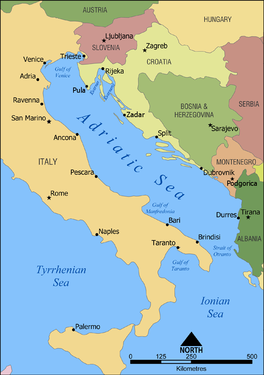
Back Адриатик амшын Abkhazian Adriatiese See Afrikaans Adriatisches Meer ALS አድሪያቲክ ባሕር Amharic Mar Hadriana AN البحر الأدرياتيكي Arabic بحر البنادقة ARY البحر الادرياتيكى ARZ Mar Adriáticu AST Adriatika Bira AVK
| Adriatic Sea | |
|---|---|
 A map of the Adriatic Sea | |
| Location | Southern Europe |
| Coordinates | 43°N 15°E / 43°N 15°E |
| Type | Sea |
| Etymology | From the ancient city of Adria |
| Primary inflows | Adige, Buna, Drin, Krka, Neretva, Po, Soča |
| Primary outflows | Ionian Sea |
| Catchment area | 235,000 km2 (91,000 sq mi) |
| Basin countries | Bordering: Italy, Albania, Croatia, Montenegro, Slovenia, and Bosnia and Herzegovina Not bordering: Greece, Serbia, North Macedonia, Kosovo, Austria, Switzerland and France (drainage basins for inflow rivers)[1] |
| Max. length | 800 km (500 mi) |
| Max. width | 200 km (120 mi) |
| Surface area | 138,600 km2 (53,500 sq mi) |
| Average depth | 252.5 m (828 ft) |
| Max. depth | 1,233 m (4,045 ft) |
| Water volume | 35,000 km3 (2.8×1010 acre⋅ft) |
| Residence time | 3.4±0.4 years |
| Salinity | 38–39 PSU |
| Shore length1 | 3,739.1 km (2,323.4 mi) |
| Max. temperature | 28 °C (82 °F) |
| Min. temperature | 9 °C (48 °F) |
| Islands | Over 1300 |
| Settlements | Ancona, Bari, Durrës, Dubrovnik, Koper, Neum, Pescara, Rijeka, Rimini, Šibenik, Split, Trieste, Venice, Vlorë, Zadar |
| 1 Shore length is not a well-defined measure. | |
The Adriatic Sea (/ˌeɪdriˈætɪk/) is a body of water separating the Italian Peninsula from the Balkan Peninsula. The Adriatic is the northernmost arm of the Mediterranean Sea, extending from the Strait of Otranto (where it connects to the Ionian Sea) to the northwest and the Po Valley. The countries with coasts on the Adriatic are Albania, Bosnia and Herzegovina, Croatia, Italy, Montenegro, and Slovenia.
The Adriatic contains more than 1,300 islands, mostly located along its eastern coast. It is divided into three basins, the northern being the shallowest and the southern being the deepest, with a maximum depth of 1,233 metres (4,045 ft). The prevailing currents flow counterclockwise from the Strait of Otranto. Tidal movements in the Adriatic are slight, although larger amplitudes occur occasionally. The Adriatic's salinity is lower than the Mediterranean's because it collects a third of the fresh water flowing into the Mediterranean, acting as a dilution basin. The surface water temperatures generally range from 30 °C (86 °F) in summer to 12 °C (54 °F) in winter, significantly moderating the Adriatic Basin's climate. The Adriatic Sea sits on the Apulian or Adriatic Microplate. In the Late Oligocene, the Italian Peninsula first formed, separating the Adriatic Basin from the rest of the Mediterranean. The western coast is alluvial or terraced, while the eastern coast is highly indented with pronounced karstification. There are dozens of marine protected areas in the Adriatic, designed to protect the sea's habitats and biodiversity—more than 7,000 species are identified as native to the Adriatic, many of them endemic, rare and threatened ones.
The Adriatic's shores are populated by more than 3.5 million people; the largest cities are Bari, Venice, Trieste and Split. Early settlements on the Adriatic shores were Etruscan, Illyrian, and Greek. By the 2nd century BC, the region was under Rome's control. In the Middle Ages, the sea was controlled, to a varying extent, by a series of states—most notably the Byzantine Empire, the Croatian Kingdom, the Republic of Venice, the Habsburg monarchy and the Ottoman Empire. The Napoleonic Wars resulted in the Austrian Empire gaining control of most of the eastern Adriatic shore and the Po Valley, while the Kingdom of Italy gradually took control of the remaining Italian coast during the 19th century. Following the collapse of Austria-Hungary in 1918, control of the eastern coast passed to Yugoslavia and Albania, which agreed on their maritime boundaries with Italy in 1975 and 1992 respectively. After Yugoslavia's dissolution during the 1990s, its four coastal successor states—Slovenia, Croatia, Bosnia and Herzegovina, and Montenegro—continued to recognise the previous maritime border with Italy, but have disputed the borders between themselves.
Fisheries and tourism are significant sources of income along the Adriatic coast. Maritime transport is also a significant branch of the area's economy—there are 19 seaports in the Adriatic that each handle more than a million tonnes of cargo per year. The largest Adriatic seaport by annual cargo turnover is the Port of Trieste, while the Port of Split is the largest by passengers served per year.
- ^ Drainage Basin of the Mediterranean Sea (PDF) (Report). UNECE. p. 253. Retrieved 30 March 2023.